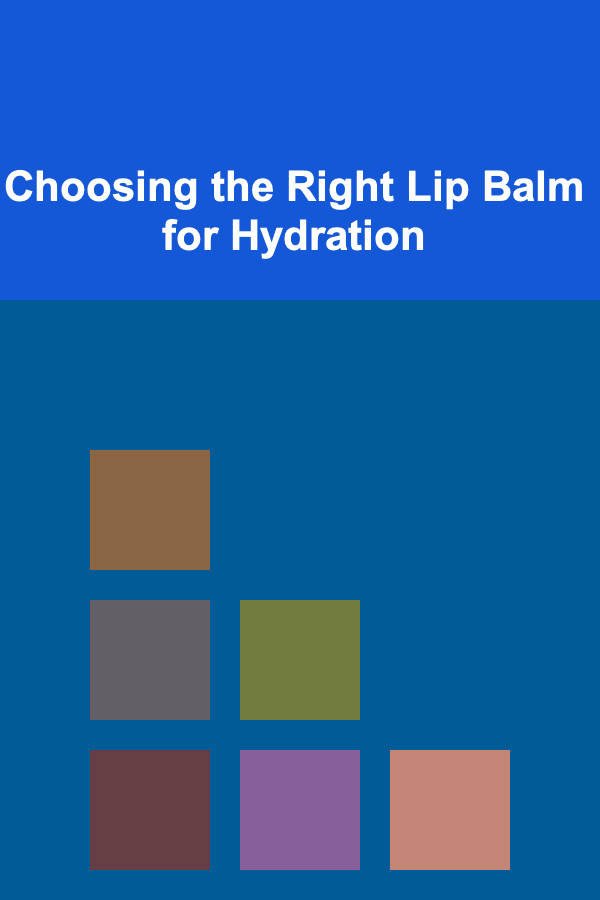
Choosing the Right Lip Balm for Hydration
ebook include PDF & Audio bundle (Micro Guide)
$12.99$9.99
Limited Time Offer! Order within the next:

Chapped lips are a common and often uncomfortable problem. The delicate skin on our lips lacks the protective layer of oil glands found elsewhere on our body, making them particularly vulnerable to environmental factors like cold weather, wind, sun exposure, and even indoor heating. Finding the right lip balm is crucial not just for immediate relief, but for long-term lip health and hydration. However, with a vast array of lip balms available on the market, navigating the options and selecting one that truly delivers effective and lasting hydration can be overwhelming. This article delves into the science of lip hydration, examines the common culprits behind chapped lips, and provides a comprehensive guide to choosing the best lip balm to achieve and maintain healthy, hydrated lips.
Understanding Lip Hydration: The Science Behind Chapped Lips
To effectively combat chapped lips, it's essential to understand the fundamental processes involved in lip hydration and the factors that compromise them. The stratum corneum, the outermost layer of the epidermis, acts as a crucial barrier preventing excessive water loss from the skin. Unlike the rest of the skin, the lips have a significantly thinner stratum corneum, making them more permeable and susceptible to dehydration. Additionally, the lips lack sebaceous glands, which secrete sebum -- a natural oil that helps to retain moisture and protect the skin from external aggressors.
This inherent vulnerability means that the lips are constantly exposed to environmental stressors that can strip them of their natural moisture. When the rate of water loss exceeds the rate of moisture replenishment, the lips become dry, cracked, and chapped. This condition can range from mild discomfort to painful fissures and bleeding. Effective lip hydration, therefore, relies on two key principles: preventing moisture loss (occlusion) and attracting moisture from the environment (humectancy).
Common Culprits Behind Chapped Lips
Before diving into the specifics of lip balm ingredients, it's important to identify the common factors that contribute to chapped lips. Recognizing these triggers can help you proactively address the underlying causes and make more informed choices about lip care.
- Environmental Factors: Cold weather, dry air (especially during winter or in arid climates), and wind exposure are major contributors to lip dehydration. These conditions accelerate the rate of transepidermal water loss (TEWL), leaving the lips parched and susceptible to cracking. Sun exposure can also damage the delicate lip tissue, leading to dryness and even sunburn.
- Dehydration: Insufficient water intake is a common cause of overall skin dryness, including the lips. When the body is dehydrated, it prioritizes water distribution to vital organs, leaving the skin with less moisture.
- Lip Licking: While it may seem counterintuitive, licking your lips actually worsens dryness. Saliva contains enzymes that can break down the skin's protective barrier, and as the saliva evaporates, it draws moisture away from the lips, leaving them even drier.
- Certain Medications: Some medications, such as those used to treat acne (e.g., isotretinoin) or allergies, can have drying side effects that contribute to chapped lips.
- Nutritional Deficiencies: Deficiencies in certain vitamins and minerals, such as vitamin B and iron, can affect skin health and contribute to dryness.
- Breathing Through the Mouth: Sleeping with your mouth open, especially during allergy season or when congested, can lead to significant lip dehydration.
- Irritating Ingredients in Lip Products: Paradoxically, some lip balms themselves can exacerbate dryness due to the presence of irritating ingredients like fragrances, menthol, camphor, and certain preservatives.
- Underlying Medical Conditions: In some cases, chronic chapped lips may be a symptom of an underlying medical condition, such as eczema, psoriasis, or cheilitis.
Decoding Lip Balm Ingredients: What to Look For
The effectiveness of a lip balm hinges on its ingredients. Understanding the different classes of ingredients and their functions is crucial for making informed choices. Lip balms generally contain a combination of occlusives, humectants, emollients, and sometimes, active ingredients to address specific concerns.
Occlusives: The Moisture Seal
Occlusives are ingredients that form a physical barrier on the surface of the lips, preventing water from escaping. They are essential for locking in moisture and protecting the lips from environmental aggressors. Common occlusive ingredients in lip balms include:
- Petroleum Jelly (Vaseline): A classic occlusive that is highly effective at preventing water loss. It is non-comedogenic (does not clog pores) and generally well-tolerated.
- Beeswax: A natural wax that provides a protective barrier and has emollient properties.
- Shea Butter: A rich emollient with occlusive properties, derived from the shea nut. It also contains antioxidants and anti-inflammatory compounds.
- Cocoa Butter: Similar to shea butter, cocoa butter is a rich emollient with occlusive properties and a pleasant scent.
- Lanolin: A natural wax derived from sheep's wool. It is a highly effective occlusive and emollient, but can be allergenic for some individuals.
- Mineral Oil: Another effective occlusive, similar to petroleum jelly.
- Dimethicone: A silicone-based occlusive that provides a smooth, silky feel.
When choosing a lip balm, prioritize those that contain a significant amount of occlusive ingredients, especially if you are prone to dry or chapped lips.
Humectants: The Moisture Attractors
Humectants are ingredients that attract moisture from the air or from the deeper layers of the skin and draw it to the surface of the lips. They help to hydrate the lips from within. Common humectant ingredients include:
- Hyaluronic Acid: A powerful humectant that can hold up to 1000 times its weight in water. It helps to plump the lips and reduce the appearance of fine lines.
- Glycerin (Glycerol): A widely used humectant that attracts moisture to the skin.
- Honey: A natural humectant with antibacterial and antioxidant properties.
- Aloe Vera: A soothing and hydrating ingredient that can help to relieve inflammation and promote healing.
- Propylene Glycol: A humectant and solvent used in many cosmetic formulations.
- Sorbitol: A sugar alcohol that acts as a humectant.
While humectants are beneficial, they work best when combined with occlusives. Without an occlusive barrier to trap the moisture, humectants can actually draw moisture away from the lips in dry environments, potentially exacerbating dryness.
Emollients: The Smooth Operators
Emollients are ingredients that soften and smooth the skin by filling in the gaps between skin cells. They help to improve the texture of the lips and reduce roughness. Many ingredients, such as shea butter and cocoa butter, act as both occlusives and emollients. Other common emollient ingredients include:
- Plant Oils (e.g., Jojoba Oil, Almond Oil, Coconut Oil, Olive Oil): These oils are rich in fatty acids that help to nourish and soften the lips. They also provide a mild occlusive barrier.
- Avocado Oil: Rich in vitamins and antioxidants, avocado oil provides intense hydration and promotes healing.
- Vitamin E (Tocopherol): An antioxidant that helps to protect the skin from damage and improve hydration.
- Squalane: A highly moisturizing and emollient ingredient derived from olive oil or sugarcane.
- Ceramides: Lipids that are naturally found in the skin and help to maintain its barrier function.
Emollients contribute to the overall feel and texture of the lip balm, making it more pleasant to apply and use.
Active Ingredients: Addressing Specific Concerns
Some lip balms contain active ingredients that target specific lip concerns, such as sun protection, exfoliation, or healing.
- Sunscreen (SPF): Protecting your lips from sun damage is crucial, especially during prolonged sun exposure. Look for lip balms with a broad-spectrum SPF of 30 or higher. Common sunscreen ingredients include zinc oxide, titanium dioxide, avobenzone, and octinoxate.
- Exfoliants (e.g., Salicylic Acid, Lactic Acid, Fruit Enzymes): Gentle exfoliation can help to remove dead skin cells and reveal smoother, healthier lips. However, be cautious with exfoliants, as overuse can irritate the lips. Use them sparingly and follow with a hydrating lip balm.
- Healing Agents (e.g., Panthenol (Pro-Vitamin B5), Allantoin, Bisabolol): These ingredients can help to soothe irritated lips and promote healing.
- Anti-inflammatory Agents (e.g., Chamomile Extract, Calendula Extract): These ingredients can help to reduce inflammation and redness.
Ingredients to Avoid: Potential Irritants
Just as important as knowing which ingredients to look for is knowing which ingredients to avoid. Certain ingredients can irritate the lips, leading to dryness, inflammation, and even allergic reactions.
- Fragrances (Parfum): Fragrances are a common cause of skin irritation and allergic reactions. Opt for fragrance-free lip balms, especially if you have sensitive skin.
- Flavorings: Similar to fragrances, flavorings can irritate the lips.
- Menthol, Camphor, Phenol: These ingredients provide a cooling sensation, but they can also be drying and irritating to the lips. They often create a cycle of dependency, where the lips feel temporarily relieved but become drier over time.
- Salicylic Acid (in high concentrations): While salicylic acid can be beneficial for exfoliation, overuse can lead to irritation and dryness.
- Alcohol: Alcohol can dry out the lips.
- Lanolin (for those with sensitivities): While lanolin is an excellent emollient and occlusive, some individuals are allergic to it.
- Certain Preservatives (e.g., Parabens, Formaldehyde-releasing preservatives): These preservatives can be irritating to some individuals.
Always check the ingredient list carefully and avoid lip balms that contain these potential irritants, especially if you have sensitive skin or a history of allergic reactions.
Choosing the Right Lip Balm: A Step-by-Step Guide
Now that you understand the science behind lip hydration and the role of different ingredients, you can confidently choose the right lip balm for your needs. Here's a step-by-step guide:
- Identify Your Lip Concerns: Are your lips chronically dry and chapped? Do you need sun protection? Are you looking for anti-aging benefits? Identifying your specific concerns will help you narrow down your options.
- Read the Ingredient List Carefully: Prioritize lip balms that contain a combination of occlusives, humectants, and emollients. Look for beneficial active ingredients based on your specific needs.
- Avoid Potential Irritants: Steer clear of lip balms that contain fragrances, flavorings, menthol, camphor, phenol, and other known irritants.
- Consider Your Skin Type: If you have sensitive skin, choose hypoallergenic and fragrance-free lip balms. If you are prone to acne, opt for non-comedogenic formulas.
- Check the SPF: If you spend a lot of time outdoors, choose a lip balm with a broad-spectrum SPF of 30 or higher.
- Read Reviews: Read online reviews to get insights from other users about the effectiveness and potential side effects of different lip balms.
- Test a Small Amount: Before applying a new lip balm liberally, test a small amount on a small area of your skin to check for any allergic reactions or sensitivities.
- Choose the Right Format: Lip balms come in various formats, including sticks, tubes, and pots. Choose the format that you find most convenient and hygienic. Sticks are generally more hygienic than pots, as you don't need to dip your fingers into the product.
Beyond Lip Balm: Maintaining Healthy, Hydrated Lips
Choosing the right lip balm is just one piece of the puzzle. To truly maintain healthy, hydrated lips, it's important to adopt a holistic approach that includes lifestyle changes and proper lip care practices.
- Stay Hydrated: Drink plenty of water throughout the day to keep your body and skin hydrated.
- Avoid Lip Licking: Resist the urge to lick your lips, as this can worsen dryness.
- Use a Humidifier: Use a humidifier, especially during the winter months or in dry climates, to add moisture to the air.
- Exfoliate Gently: Gently exfoliate your lips once or twice a week to remove dead skin cells. You can use a soft toothbrush or a专门的lip scrub.
- Protect Your Lips from the Sun: Apply a lip balm with SPF whenever you are exposed to the sun.
- Avoid Irritating Products: Avoid using harsh soaps, detergents, or other products that can strip your lips of their natural oils.
- Don't Pick or Peel: Avoid picking or peeling at chapped lips, as this can lead to infection and scarring.
- See a Dermatologist: If your chapped lips are severe, persistent, or accompanied by other symptoms, consult a dermatologist to rule out any underlying medical conditions.
- Apply Lip Balm Regularly: Apply lip balm liberally and frequently throughout the day, especially before going to bed.
By following these tips, you can achieve and maintain healthy, hydrated lips and say goodbye to chapped lips for good.
Conclusion
Choosing the right lip balm for hydration requires a thoughtful approach that considers your individual needs, ingredient lists, and lifestyle factors. By understanding the science behind lip hydration, avoiding potential irritants, and adopting proper lip care practices, you can effectively combat chapped lips and achieve a healthy, comfortable pout. Remember that consistency is key. Regular application of a hydrating lip balm, coupled with a healthy lifestyle, is the best way to keep your lips soft, smooth, and supple.

How to Budget for a New Home with an Existing Mortgage
Read More
How to Cut Back on Impulse Purchases for Your Home
Read More
How to Organize Tech Gear in a Compact Workstation
Read More
How to Soundproof Your Home from External Traffic Noise
Read More
How to Get Cheap Accommodation in Major Cities
Read More
Creating a Minimalist Morning Routine: A Guide to Clarity and Focus
Read MoreOther Products

How to Budget for a New Home with an Existing Mortgage
Read More
How to Cut Back on Impulse Purchases for Your Home
Read More
How to Organize Tech Gear in a Compact Workstation
Read More
How to Soundproof Your Home from External Traffic Noise
Read More
How to Get Cheap Accommodation in Major Cities
Read More